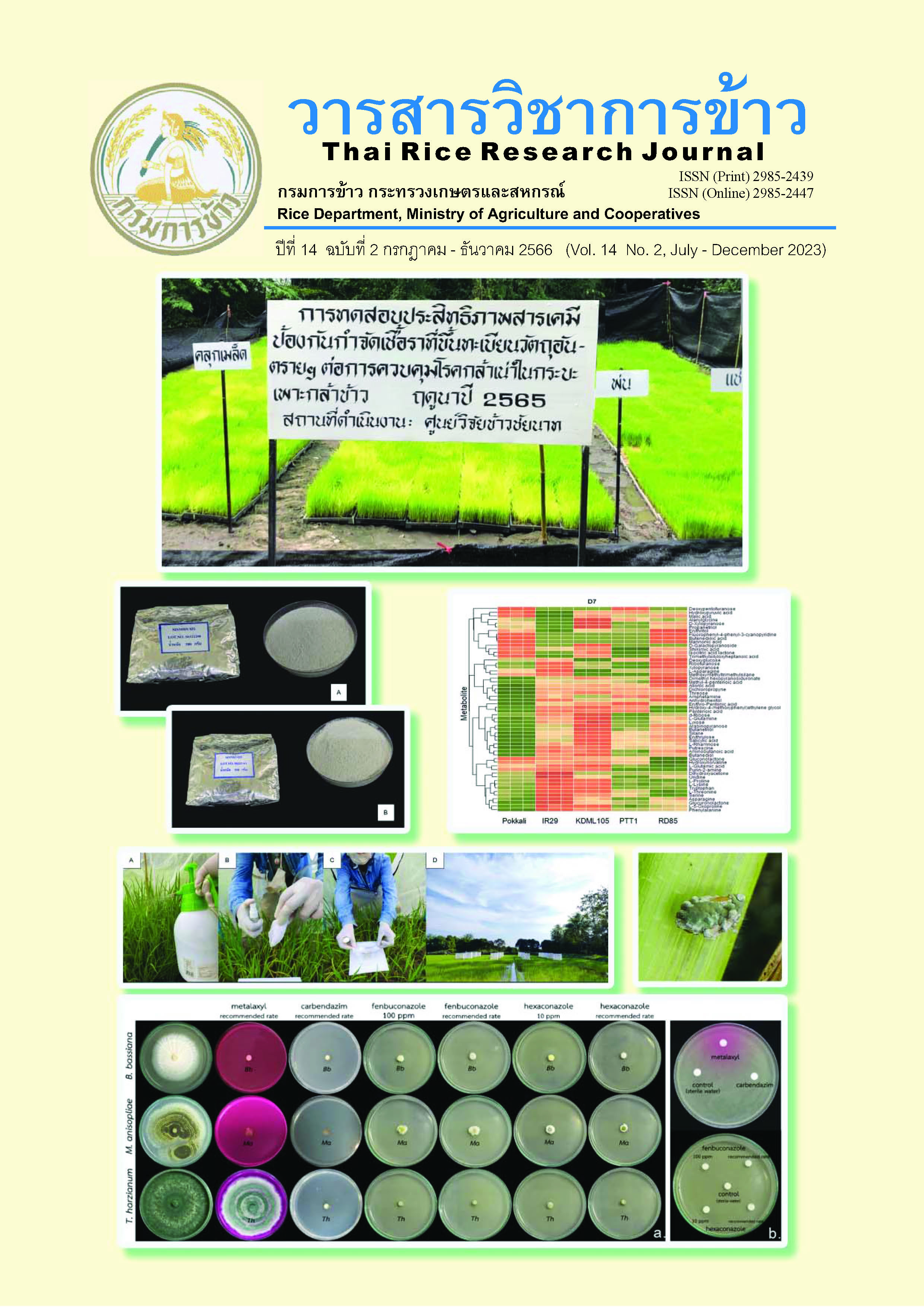Extension Model for Development and Utilization of Rice Research in Thailand
Main Article Content
Abstract
The objectives of this research were to 1) synthesize the model and utilization of rice research 2) study factors relating to the research method and utilization of rice research and 3) develop and evaluate the extension model and utilization of rice research. The research was a mixed method research which was divided into 3 steps: step 1 synthesizing rice research information from 2016-2020 with the total number of 147 projects. The sample size was done through purposive sampling method. The research results were synthesized by determining the topics of questionnaires to collect quantitative data by specifying the sample group via Taro Yamane formula with the error value of 0.05 including 133 researchers, 175 agricultural extension officers, and 232 farmers. Step 2 was extension model development for development and utilization of rice research in Thailand. Data were collected from qualitative information and focus group. The sample size of 20 people was determined by using purposive sampling method including rice experts, researchers, agricultural extension officers, and farmers. Step 3 was model evaluation. The sample size of 30 people included rice experts, researchers, agricultural extension officers, and farmers through purposive sampling method.
The results of the research found that 1) for rice research synthesis, the rice research was mostly having research objectives to study. The research production unit was an educational institute. The rice research was mostly on production technology and new knowledge creation. The knowledge transfer methods were done through publication and distribution via manuals/publication. They utilized the information academically. 2) Factors relating to the research model and the utilization of rice research consisted of 4 aspects such as (1) rice research model was a quantitative research which came from research fund resource with the objectives to research and develop. There was a research hypothesis determination, utilization of research results for work improvement, and the development of farmers and community. Literature source was done through internet system. The researcher would like to study the population and sample size were the rice species. The sample group was determined by using systematic probability sampling and nonprobability sampling methods. Tool used was a test form. Regarding the agricultural extension officers, they wanted to study the population and the sample group was farmers. The sample size was determined by using simple random sampling method and nonprobability sampling method. Tool used was questionnaires. Reliability test for equipment was being utilized. Data were analyzed by using descriptive analysis. Research distribution was mainly through personal media and electronic media. (2) The utilization of research for academic purpose, social/community purpose, and economic purpose were done to create economic security, to increase productivity, and to decrease production cost. (3) Problems in the development and the utilization of rice research were such as outdated and insufficient tools and equipment, lack of research on marketing which would connect with the research on production, lack of information system for research, difficulty in accessing the data sources, difficult presentation of the research and communication for understanding and further application. (4) For research extension and utilization of rice research regarding the knowledge aspect, they mostly need knowledge on species through personal media who were scholars. In regards to channel or media, they needed it through electronic media. The form/method of extension would be through training, field trip, and practice. 3) The extension model and utilization of rice research in country started from determining the objectives to develop rice research in response to the needs of farmers and so that farmers would be able to adapt into their daily life or to adopt it for their profession by taking the knowledge from rice research, transferring such knowledge through personal media and technology to increase the adoption process by using 6Rs principles as the framework in knowledge transfer process. The principles included research design, research advisor, rice research pattern, research method, research communications, and research target creating the benefit in economic aspect, community and society aspect, rice innovation aspect, and academic aspect. This has changed from the old way to the improvement regarding policy, rice extension work, and future academic work to adopt research and technology into real practice which will create good results in rice production, higher income for farmers, better quality of life, and ability to sustainably self-dependent.
Article Details
References
กฤษณพงศ์ ศรีพงษ์พันธุ์กุล. 2561. กรมการข้าวเตรียมพร้อมเร่งสรุป เพื่อกำหนดทิศทางการดำเนินงานอย่างมีเอกภาพเพื่อการวิจัยพัฒนา-ส่งเสริมการผลิตข้าวของประเทศไทย. สืบค้นจาก: http://www.ricethailand.go.th/web/index.php/mactivities/4224-2018-09-13-03-55-35. (26 มีนาคม 2565)
ก่อศักดิ์ ไชยรัศมีศักดิ์. 2561. ข้าวไทยในโลกอนาคต. สืบค้นจาก: https://www.thairath.co.th/content/1401772. (11 มีนาคม 2565)
ชุติมา บุณยประภัศร. 2559. เปลี่ยน! ได้เวลาปฏิวัติข้าวไทยทั้งวงจร. ข้าวไทย 8(53): 38-47.
ชุติมา บุณยประภัศร. 2560. การพัฒนาข้าวไทยอย่างยั่งยืน. สืบค้นจาก: https://www.prachachat.net/ economy/news-12331. (5 มีนาคม 2565)
ดวงกมล วงศ์จันทร์, แววตา เตชาทวีวรรณ และธาดาศักดิ์ วชิรปรีชาพงษ์. 2554. การวิเคราะห์วิทยานิพนธ์ระดับปริญญามหาบัณฑิต สาขาบรรณารักษศาสตร์ และสารสนเทศศาสตร์ในประเทศไทยที่เผยแพร่ระหว่างพ.ศ. 2542-2551. วารสารบรรณศาสตร์ มศว. 4(1): 29-39
นิพนธ์ พัวพงศกร. 2557. ทิศทางการพัฒนาด้านการเกษตรและการวิจัยเพื่อสร้างชุมชนที่เข้มแข็ง. แก่นเกษตร 42(1): 1-6.
บุหลัน กุลวิจิตร. 2560. สื่อบุคคลกับการส่งเสริมการเกษตร 4.0. Veridian E-Journal,Silpakorn University ฉบับภาษาไทย สาขามนุษยศาสตร์ สังคมศาสตร์และศิลปะ 10(3): 2440-2454.
พีรเดช ทองอำไพ. 2556. ทิศทางวิจัยข้าวไทย. สืบค้นจาก: https://www.rakbankerd.com/agriculture/print.php?id=6166&s=tblrice. (6 มีนาคม 2565)
มยุรา ฉลูทอง. 2563. การสังเคราะห์งานวิจัยเกี่ยวกับการจัดการเรียนรู้ที่ส่งเสริมจิตสาธารณะโดยการวิเคราะห์อภิมาน. วารสารมหาจุฬานาครทรรศน์ 7(11).
ศักดิ์ชาย ตั้งประเสริฐ และนลินภัสร์ ปรวัฒน์ปรียกร. 2557. การถ่ายทอดความรู้ในบริบท การบูรณาการระบบสารสนเทศ: การทบทวนวรรณกรรม อย่างเป็นระบบ. วารสารเทคโนโลยีสารสนเทศ 10(2): 70-84.
สดศรี ทุมมาเกตุ. 2559. แนวทางการส่งเสริมด้านเคหกิจเกษตรสำหรับกลุ่มแม่บ้านเกษตรกรในจังหวัดฉะเชิงเทรา. หน้า 1-17. ใน: การประชุมเสนอผลงานวิจัยระดับชาติ มหาวิทยาลัยสุโขทัยธรรมาธิราช ครั้งที่ 6. 25 พฤศจิกายน 2559. มหาวิทยาลัยสุโขทัยธรรมาธิราช, กรุงเทพฯ.
สมพร อิศวิลานนท์ และศานิต เก้าเอี้ยน. 2552. ความเป็นพลวัตของเศรษฐกิจการผลิตของข้าวไทยและการมองไปข้างหน้า. ภาควิชาเศรษฐศาสตร์เกษตรและทรัพยากร มหาวิทยาลัยเกษตรศาสตร์, กรุงเทพฯ. 148 หน้า.
สมาคมผู้ส่งออกข้าวไทย. 2565. เปรียบเทียบการส่งออกข้าวของประเทศผู้ส่งออกที่สำคัญ 5 อันดับ. สืบค้นจาก: http://www.thairicerexportera.or.th. (2 เมษายน 2565)
สุนันทา ศรีม่วง. 2558. การสังเคราะห์งานวิจัยที่ได้รับทุนจากมหาวิทยาลัยราชภัฏพระนคร ปี พ.ศ. 2555-2556. วารสารวิจัยราชภัฏพระนคร. 10(2): 80-90.
สำนักงานคณะกรรมการวิจัยแห่งชาติ (วช.). 2560. บทสรุปสำหรับผู้บริหาร ยุทธศาสตร์การวิจัยรายประเด็นด้านข้าว พ.ศ. 2560. สืบค้นจาก: http://www.research.nu.ac.th/th/uploads/files/Gov%20Budget%2061/3.pdf. (18 มีนาคม 2565)
อภิชัย สมบูรณ์ปกรณ์ และคณะวิจัย บริษัท ไลออน จำกัด. 2562. โครงการประเมินความสอดคล้องการจัดสรรทุนมุ่งเป้าเรื่องข้าวและแนวทางการจัดสรรทุนเพื่อรองรับนโยบายเร่งด่วนในการพัฒนาข้าวของประเทศ ระยะที่ 2. สำนักงานพัฒนาการวิจัยการเกษตร (องค์กรมหาชน), กรุงเทพฯ. 229 หน้า.
Creswell, J.W. 2013. Research Design: Qualitative, Quantitative, and Mixed Methods Approaches. (4th ed.). Sage Publications, Inc., London.
Poapongsakorn, N. 2012. Development of Thai rice industry and public rice research. In: Presentation of the 1st International rice science conference in Thailand “Rice Research: The Way Forward”. August 30-31, 2012. IMPACT Exhibition Center, Bangkok.
